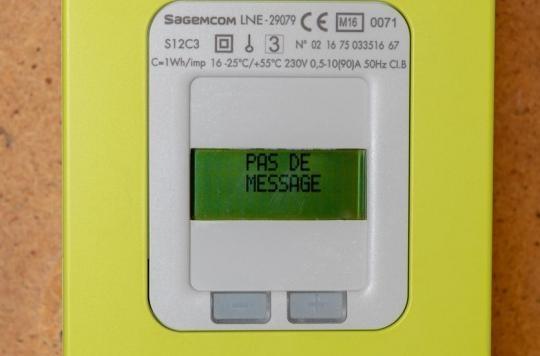After measuring a hundred sites, the National Frequency Agency (ANFR) concluded that the electromagnetic radiation from Linky meters, which many people want to get rid of, was within the norm and therefore presented no danger.

“The compliance of the level of exposure to electromagnetic fields was observed on all sites”. After years of controversy over the alleged dangerousness of Linky meters, the National Frequency Agency (ANFR) has decided. These controversial machines, which are used to communicate the electricity consumption of a household in real time to electricity suppliers, do not pose any health risks, explains the body responsible for managing radio frequencies in France. in a report published on October 9.
Since the 2015 law on energy transition, the Linky meter must equip 35 million homes by 2021. However, since Enedis, the company managing the French electricity network, began installing this box in housing instead of traditional meters, many people complain of various and varied symptoms such as fatigue, hives or depression.
In May 2018, 300 people made people talk about them by forming a human chain in the village of Autrans in Isère to protest against this machine. Since the installation of the latter, twenty-two courts have already been seized of joint actions in France. But most of the plaintiffs were dismissed. In the Center region, out of 121 anti-Linky referrals, cited in three judgments and filed by residents opposed to the break of this meter at home, 108 were rejected while only 13 were admitted for medical reasons.
Waves lower than those of a computer or a low-energy light bulb
Faced with the controversy, the ANFR, which ensures compliance with the standards in force in terms of wave emission, had already published a report on electromagnetic fields in 2016. Of the five meters tested, the values read were 100 to 350 times lower than current standards. This time, the agency carried out measurements in 178 homes spread throughout France for six months. She found electromagnetic radiation 25 to 37 times lower than the legal ceiling. If these rates are higher than previous measurements, they remain within the norm.
In addition, communication between the Linky boxes and the neighborhood transformers takes place on the line carrier current, which transmits information through the electrical network. “Since they transmit their information by wire, Linky meters are therefore not radio transmitters”, notes the Agency. Like any electrical device, they do emit waves but they are lower than those produced by a computer, a low-energy light bulb or a refrigerator, according to the World Health Organization (WHO).
At present, in all, 22 proceedings have been brought against Linky meters in France by 5,000 plaintiffs. Several of them were returned on the merits, thus lengthening the procedure.
The complexity of the phenomenon of “electro-sensitivity”
People who complain of electromagnetic hypersensitivity, a disease not recognized by the WHO, report, for example, great fatigue and difficulty concentrating, headaches and dizziness, nausea, tinnitus, digestive disorders, palpitations heart, tingling and burning sensations in the ears or an anxious or depressed state.
According to two wave specialists recently interviewed by Why Doctor about the widespread deployment of 5G in 2020, if this suffering is real, it has no medical link with exposure to waves.
“They are really sick people, their symptoms are real, they are not crazy. Now whether the waves are really the cause of their discomfort, that is another question. In the studies carried out in the laboratory, we tried to expose these people without their knowledge to see if they triggered their symptoms. In vain: we can’t manage to expose them by surprise without them knowing or to create their symptoms in the laboratory . Also, perhaps the waves are partly responsible for their discomfort, but they are certainly not the only ones. We are in a much more complex situation”, explained in particular Yves Le Dréan, researcher for Inserm in the Irset unit (Institute for Research in Health, Environment and Work) at the University of Rennes. And to add: “At the moment, we are trying to find avenues of work to try to understand what they have and to offer them therapies because for the moment they are in a medical wandering, we do not know. the origin of their illness and it is very heterogeneous. Moreover, they do not all complain of the same type of waves. It is very complicated”.
“A phenomenon of anxiety disorder, phobia”
“I think we are in a phenomenon of anxiety disorder, of phobia, which causes these people to develop an aversion to waves and avoidance behaviors which cause them to have symptoms typical of panic or anxiety disorders: fatigue, stress… We see that whatever they do, they confirm their belief via, for example, the purchase of anti-wave objects and sink into a spiral”, declared Sébastien Point, physicist, president of the non-ionizing radiation section of the French Society for Radiation Protection and member of the French Association for Scientific Information, recommending to patients a “cognitive behavioral therapy which would allow them to dissociate their symptoms from the exposure to the waves”.
.
















